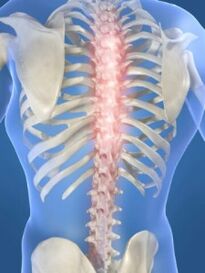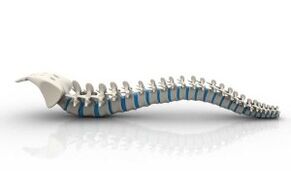Let's look at the symptoms and treatment of thoracic osteochondrosis, because in rare cases, the spine is not active in the thoracic region, but is firmly attached to the ribs. The main reason for the development of symptoms is scoliosis, curvature of the spine. Manifestations and development of the disease are formed in early school age.
The disease often occurs in drivers and office workers who sit in an awkward position at the table for many years and do not pay attention to their posture. The thoracic vertebra bends simultaneously with the nerve fibers, ligaments, and muscles throughout the patient's life. There is tension, pressure, extra load on the spine, which leads to the development of the disease.
The presence of symptoms of thoracic osteochondrosis differs from the symptoms that occur. The disease is not pronounced, there is no sharp persistent pain, there are unpleasant pains of a constantly aching nature. It is difficult for a doctor to diagnose thoracic osteochondrosis. The symptoms are similar to gastroenterological diseases, the pain is similar to angina pectoris, myocardial infarction.
Symptoms

Thoracic lumbar osteochondrosis adversely affects the liver, kidneys and pancreas. It often causes heart and intestinal diseases. The disease manifests itself in different ways, there is no way to correctly distinguish a number of symptoms that allow to make a correct diagnosis - osteochondrosis of the thoracic region. Presence of characteristic symptoms:
- Unpleasant intercostal girdle pain aggravated by deep inspiration.
- Burning in the chest.
- Numbness of the upper extremities, pain when rising up.
- Unpleasant pain in the stomach, liver, heart.
- It is difficult to bend the body.
- It causes impotence in men.
The disease is characterized by strong, unpleasant intercostal pain. The patient has difficulty breathing, pain increases with hypothermia, flexion of the body. The pain is severe, unpleasant at night. It's like a heart attack. In women, as the disease progresses, osteochondrosis spreads to the chest and causes pathological changes in the female mammary gland. Severe pain with an inflammation lasts for several days.
Due to the complexity of the diagnosis, the symptoms and treatment of thoracic osteochondrosis are prescribed only by a doctor! Self-medication often leads to undesirable consequences, complications and other diseases.
Dorsago and dorsalgia
Thoracic osteochondrosis of the spine is accompanied by 2 vertebral syndromes:
- Dorsago. Workers have a sharp, sharp pain in the sternum, bending for a long time. Severe pain is seen above, it is difficult to breathe. Movement in the thoracic region is limited.
- Dorsalgia begins gradually, without being felt. When the body bends, deep breathing and discomfort, light pains appear.
It is indicated by muscle tension that restricts movement: upper dorsalgia - in the cervical region, lower - in the lumbar, thoracic region. The pain is aggravated by rest at night, gradually disappears when walking in the morning. When a person sits in a restless state for a long time, the pain gradually intensifies.
Complications
With the disease, there are other manifestations of pain that complicate the diagnosis, disorders:

- Upper thoracic segment - esophagus, sore throat, chest pain.
- Middle thoracic segment - pain similar to pain in gastroenterological diseases appears in the right hypochondrium.
- Low thoracic spine - sudden sharp pain in the abdomen.
Pain is not seasonal, it is inaccurate. Growth after physical exertion. The pain subsides after a full night's rest, and often disappears completely.
If the disease is diagnosed and treated late, it can lead to disease and damage to internal organs. A serious complication is the formation of pathology, coronary heart disease, changes in the heart. Disorders of the duodenum, intestinal motility, gallbladder dyskinesia.
Diagnostics
The disease is poorly diagnosed. The symptoms of thoracic osteochondrosis are similar to those of myocardial infarction and angina pectoris. There is no relief when taking heart medication with thoracic osteochondrosis. The patient's electrocardiogram is normal. The doctor will correctly diagnose the disease when prescribing magnetic resonance imaging and X-ray examinations to the patient.
Methods of treatment
The main goal of doctors in the implementation of therapeutic measures is to eliminate acute, excruciating pain in the curved areas of the spine, neurologically specific manifestations and complete recovery of the patient. Treatment:
- Medications;
- Exercise therapy;
- Physiotherapy.
Medical treatment begins with the appointment of analgesics and anti-inflammatory drugs by a doctor. Tablets for osteochondrosis of the chest - baralgin. Physiotherapy, hand therapy, exercise therapy are prescribed by a doctor.
The purpose of physiotherapy is to improve blood circulation and cerebrospinal fluid. Muscle tension is eliminated, the inflammatory process in the problem area is reduced, pain is eliminated. Exercise therapy aims to prevent and treat the disease. Therapeutic exercises relax and move the deformed part of the spine.
The doctor prescribes exercise therapy in combination with muscle relaxation in the acute phase of the disease. Breathing exercises are prescribed after the pain subsides and disappears. Reflex methods are used in the treatment of thoracic osteochondrosis. Thanks to the technique, the mobility of the back is restored.
Acupuncture (acupuncture) aims to get rid of spasms for muscle hypertension. With the help of acupuncture, an effect that improves the function of blood vessels, has a beneficial effect on blood supply, nutrition of the tissues of the intervertebral discs.
The effectiveness of acupuncture increases with moxibustion, physiotherapy, cup massage, manual, vacuum therapy. The combination of treatment methods of the disease ensures efficiency and safety. It is the basis of a strictly prescribed course for each patient.
With the help of effective methods, doctors are able to return the intervertebral discs of problem areas to normal function, to move forward, to stop the exacerbation of thoracic osteochondrosis. Progressive treatments stimulate the regeneration of the nucleus pulposus, ring fibrosis.
Effective treatment technologies eliminate the unpleasant, uncomfortable feelings of the disease - prevent pain, complications of osteochondrosis, in the absence of treatment, bulges appear in the form of hernias.
For a patient with thoracic osteochondrosis, prophylactic, therapeutic protective gymnastics, which complements the medical, drug treatment prescribed by a doctor, is important. Helps the patient to properly and skillfully shape the muscle corset to prevent relapses and complications of the disease.

















































